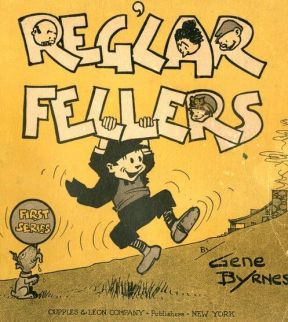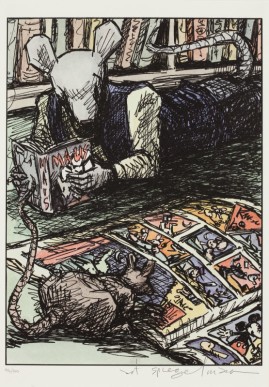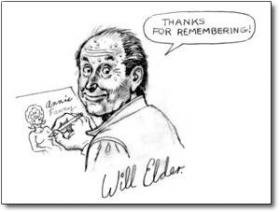Enemy Contact! (Two-Fisted Tales, 1951) by Jack Davis
27 Wednesday Nov 2013
Posted in comics, Enemy Contact!, Jack Davis, Two-Fisted Tales
27 Wednesday Nov 2013
Posted in comics, Enemy Contact!, Jack Davis, Two-Fisted Tales
26 Tuesday Nov 2013
Posted in comics, Gene Byrnes, Reg'lar Fellers
Reg’lar Fellers
 was a long-run newspaper comic strip adapted into a feature film, a radio series on NBC and two animated cartoons. Created by Gene Byrnes (1889-1974), the comic strip offered a humorous look at a gang of suburban children (who nevertheless spoke like New York street kids). Syndicated from 1917 to 1949, Byrnes’ strip was collected into several books.
was a long-run newspaper comic strip adapted into a feature film, a radio series on NBC and two animated cartoons. Created by Gene Byrnes (1889-1974), the comic strip offered a humorous look at a gang of suburban children (who nevertheless spoke like New York street kids). Syndicated from 1917 to 1949, Byrnes’ strip was collected into several books.
While working as a sports cartoonist with the New York Telegram, Byrnes created his cartoon panel It’s a Great Life If You Don’t Weaken which introduced the Reg’lar Fellers characters in 1917. He began Wide Awake Willie as a New York Herald Sunday page in 1919, and this too featured Reg’lar Fellers characters. With Reg’lar Fellers distributed by the Bell Syndicate as a daily strip in 1920, Byrnes changed the name of the Sunday strip to Reg’lar Fellers. At its peak, the strip was syndicated in 800 newspapers. It was imitated by other strips, notably Ad Carter’s Just Kids.
(en.wikipedia.org)
25 Monday Nov 2013
Posted in Art Spiegelman, comics, Maus
 In 1991 by American cartoonist Art Spiegelman. It depicts Spiegelman interviewing his father about his experiences as a Polish Jew and Holocaust survivor. The book uses postmodern techniques—most strikingly in its depiction of races of humans as different kinds of animals, with Jews as mice, Germans as cats and non-Jewish Poles as pigs. Maus has been described as memoir, biography, history, fiction, autobiography, or a mix of genres. In 1992 it became the first graphic novel to win a Pulitzer Prize.
In 1991 by American cartoonist Art Spiegelman. It depicts Spiegelman interviewing his father about his experiences as a Polish Jew and Holocaust survivor. The book uses postmodern techniques—most strikingly in its depiction of races of humans as different kinds of animals, with Jews as mice, Germans as cats and non-Jewish Poles as pigs. Maus has been described as memoir, biography, history, fiction, autobiography, or a mix of genres. In 1992 it became the first graphic novel to win a Pulitzer Prize.
In the frame tale timeline in the narrative present, beginning in 1978 in the Rego Park section of New York City, Spiegelman talks with his father about his Holocaust experiences, gathering material for the Maus project he is preparing. In the narrative past, Spiegelman depicts these experiences, starting in the years leading up to World War II. Much of the story revolves around Spiegelman’s troubled relationship with his father, and the absence of his mother who committed suicide when he was 20. Her grief-stricken husband destroyed her written accounts of Auschwitz. The book uses a minimalist drawing style while displaying innovation in its page and panel layouts, pacing, and structure.
A three-page 1972 strip by Spiegelman, also called “Maus”, was the impetus for Spiegelman to interview his father about his life during World War II. The recorded interviews became the basis for the graphic novel, which Spiegelman began in 1978. Maus was serialized from 1980 until 1991 as an insert in Raw, an avant-garde comics and graphics magazine published by Spiegelman and his wife, Françoise Mouly. It was one of the first graphic novels to receive academic attention in the English-speaking world.
(en.wikipedia.org)
Arthur Spiegelman
 was born in Stockholm, Sweden, and immigrated to the United States with his parents in his early childhood. Spiegelman studied cartooning in high school and started drawing professionally at age sixteen. Despite his parents wanting him to become a dentist, Art Spiegelman majored in art and philosophy at Binghamton University’s Harpur College of Arts. After leaving college in 1968, he joined theunderground comix movement.
was born in Stockholm, Sweden, and immigrated to the United States with his parents in his early childhood. Spiegelman studied cartooning in high school and started drawing professionally at age sixteen. Despite his parents wanting him to become a dentist, Art Spiegelman majored in art and philosophy at Binghamton University’s Harpur College of Arts. After leaving college in 1968, he joined theunderground comix movement.
The following decade, Spiegelman became a regular contributor to various underground publications, including Real Pulp, Young Lust and Bizarre Sex. Under a variety of pseudonyms like Joe Cutrate, Skeeter Grant and Al Flooglebuckle he drew creations such as ‘Ace Hole, Midget Detective’, ‘Nervous Rex’, ‘Douglas Comics’ and ‘Cracking Jokes’. In 1975, he and Bill Griffith co-founded Arcade, an influential comix revue with artists like Robert Crumb, S. Clay Wilson and Justin Green.
Besides his cartooning career, Art Spiegelman edited several comix magazines. In 1980, he started the magazine Raw with his wife Françoise Mouly. In the pages of Raw, Spiegelman helped reveal important American talents like Mark Beyer, Chris Ware, Dan Clowes, Charles Burns, J. Otto Seibold, Kaz and Jerry Moriarty, as well as artists from foreign shores such as Ever Meulen, Pascal Doury, Jacques Tardi andJoost Swarte, among others.
With the publication of the first rendition of ‘Maus’ in Funny Animals in 1972, Spiegelman’s career really took flight. ‘Maus’ was based on the experiences of his parents as concentration-camp survivors. He expanded this premise into a full-blown graphic novel, which he drew from 1980 to 1986, with the Jews presented as mice and the Germans as cats (the Katzies). The book ‘Maus: A Survivor’s Tale’, earned Spiegelman fame. He completed the tale in 1991 with ‘Maus II: From Mauschwitz to the Catskills’. Art Spiegelman received the Pullitzer Prize in 1992.
In the 1990s, besides his illustration work for books such as ‘The Wild Party’ and covers for The New Yorker, Spiegelman has used his editorial skills to put together the children’s comics anghology ‘Little Lit’ together with Françoise Mouly, and he also serves as an advisor on Mouly’s ‘TOON Books’ project. Apart from the contributing members from Raw, the ‘Little Lit’ series contains work by artists outside the comics field, such as William Joyce, Maurice Sendak, Ian Falconer, Marc Rosenthal, Claude Ponti, David Macaulay,Barbara McClintock and Harry Bliss.
In the wake of the disaster of 11 September 2001, which happened around the corner from where he lives (Greenstreet/Canalstreet), Spiegelman has made a Sunday page format story about the terrorist assault on the World Trade Center in New York, called ‘In the Shadow of No Towers’.
Art Spiegelman has been of great importance for the re-appraisal of the comics genre as an adult artform. He won the Grand Prix at the 2011 Angoulême International Comics Festival.
(lambiek.net)
24 Sunday Nov 2013
Posted in comics, Mad Magazine, Robinson Crusoe, Will Elder
24 Sunday Nov 2013
Posted in Shadow, Will Elder
William (Bill or Will) Elder
 was born as Wolf Eisenberg in New York City in 1921 and attended the New York High School of Music and Art, as did many comic book artists. There, he met Harvey Kurtzman, with whom his career would show more than one remarkable parallel. He subsequently studied at the Academy of Design, before joining the army in 1942. He was present at the disembarkation in Normandy in June 1944, and participated in the liberation of Cologne. Back in civil life in 1946, he began a studio together with Harvey Kurtzman and Charles Stern. Elder’s first comic job was ‘Rufus Debree’, a story for they Toy Town comic in 1947.
was born as Wolf Eisenberg in New York City in 1921 and attended the New York High School of Music and Art, as did many comic book artists. There, he met Harvey Kurtzman, with whom his career would show more than one remarkable parallel. He subsequently studied at the Academy of Design, before joining the army in 1942. He was present at the disembarkation in Normandy in June 1944, and participated in the liberation of Cologne. Back in civil life in 1946, he began a studio together with Harvey Kurtzman and Charles Stern. Elder’s first comic job was ‘Rufus Debree’, a story for they Toy Town comic in 1947.
During the early years of his comics career, he worked mainly as the inker of John Severin. Between 1948 and 1951, they produced ‘American Eagle’ in Prize Comics Western for Crestwood, and did occasionally comic book art for National and Nedor. In late 1950, they joined EC Comics, where they cooperated on stories for ‘Two-Fisted Tales’, ‘Frontline Combat’ and ‘Weird Fantasy’. Elder illustrated two Al Feldstein scripted stories on his own for ‘Weird Science’ issues 14 and 19. From 1953, he also contributed some stories to EC’s horror and crime titles, sometimes in collaboration with Jack Kamen.
Elder was one of the original artists of Harvey Kurtzman’s ‘Mad’ from its first issue in October/November 1952. He specialized in parody and satire, making fun of established characters like ‘Mickey Mouse’, ‘Mandrake’ and ‘Archie’. From 1954 to 1956, he was also present in EC’s other humor title, ‘Panic’. Elder left EC together with Kurtzman in 1956, and Elder went on to satirize commercial illustrators in Trump, Kurtzman’s shortlived magazine financed by Playboy’s Hugh Heffner. Elder also worked for the other Kurtzman titles, Humbug and Help!, in which he parodied ‘Frankenstein’, ‘Around the World in 80 Days’ and ‘Tarzan’. For Help!, Elder and Kurtzman also created the character ‘Goodman Beaver’.
n 1962, Elder and Kurtzman gave ‘Goodman Beaver’ a gender change, and turned him into ‘Little Annie Fanny’, whose stories were published in Playboy. They worked on ‘Little Annie Fanny’ until September 1988, sometimes assisted by Al Jaffee, Jack Davis, Russ Heath and other Mad artists. From 1959, Elder was also a versatile illustrator. He illustrated book covers, movie posters and advertisements for television programs in TV Guide (1976-1985). From 1985 and 1987, Elder and Kurtzman made a comeback in Mad magazine.
lder and Kurtzman’s collaboration lasted until 1988, the year Elder retired. Elder – the clown of the couple – always added small extra jokes in the panels when Kurtzman had finished scripting and penciling them (Chinese restaurant ‘Few Men Chew’). Later, top underground comix artists like Robert Crumb and Art Spiegelman remembered the team of Bill Elder and Harvey Kurtzman as a major influence on their comix. Elder died on May 15, 2008 from complications due to Parkinson’s disease.
(lambiek.net)
The greatest WordPress.com site in all the land!
¡Compartiendo lo mejor del Noveno Arte!
A continuing mission to produce flash fiction stories in 300 words (or less)
...la vida misma...
Random and Abstract Lines
I just want to say one word to you. Just one word. Plastics.
The Art Diary of Dawn Henning, a Brooklyn Artist...
An IT Architecture Perspective...
comics, pop culture and related topics
This is a blog about nothing, but finds a way to cover everything.
Donkey Education
Living In The Past Since 2009
Litter from the noggin with a little love in between.
The works and artistic visions of Ken Knieling.
News and opinions regarding comics, publishing, and other stuff from Ink and Feathers Comics
buzzing head
This WordPress.com site is the cat’s pajamas
Art & Design
Open a vein, see what flows
visionary author
Ever wondered what goes on when the proprietor of secondhand record shop at the butt end of the world chucks in the towel and goes back to having a life??
PTE Egyetemi Könyvtár és Tudásközpont (Esemény Blog)
Embrace Your PUNCHY Nature
A Blog of the Ridiculous and Sublime, by Mark Sackler
In Trash We Trust
A literary blog of poet, playwright and essayist Rachael Stanford
The Diary of a Retiree
A bucket list blog: exploring happiness, growth, and the world.
An Independent, Alternative Comic Book
Because my life is consistently too inconsistent for "regular" sized things
All my banned posts are here!
Kalabalu.WordPress.com site
lost gun won't travel
http://www.karenmontaguereyes.com ~ clearaguaazul at yahoo.com
Indy Wrestling, MMA, Comic, Anime, & Gaming News
Life as it was reported back then
Celebrating Nature and Magic for Kids of all Ages
fiction, poetry & stuff
A Népi Front blogja
Media Production and Marketing from the heart of Cardiff
** OFFICIAL Site of Artist Ray Ferrer **
A Girly Traveler's Journey
A history of pavement art!
From Zero to Comic-Book Hero in One Year (Hopefully)
Official Blog of Kevin Cullen & Friends
Mike Culpepper's blog about stuff that interests him.
Comics and cosmical thoughts
Welcome !